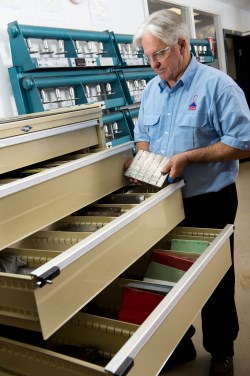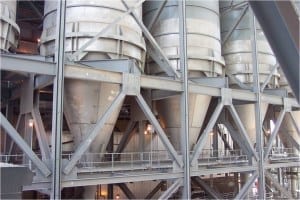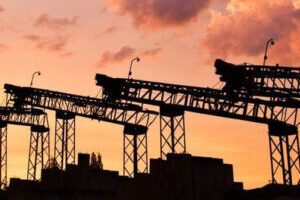Services List
-
Services By Handling Problems

Wear and Attrition Testing
Any mechanical devices which involve the motion of bulk solids relative to surfaces will experience wear problems.
Wear in bulk handling equipment may result from impact or abrasion or, as is often the case, a combination of both. In addition, deterioration of metal surfaces can occur as a result of corrosion.
Several areas where abrasive wear is experienced include storage bins and silos, particularly in hoppers operating under mass flow conditions, feeders, transfer chutes, belt conveyors, vibratory conveyors and screw conveyors. TUNRA Bulk Solids offers the following services related to abrasion, erosion and attrition:
Wall Liner Abrasive Wear Testing
The wear properties of a wear liner when abraded with a bulk material sample can be determined by performing time tests in a horizontal circular wear tester.
This wear tester simulates open three body wear with no impact as experienced in hoppers and chutes.
Abrasive wear testing outcomes:
- Determination of wear rate of surface material for specific applications
- Wear surface characterisation and analysis of wear mechanisms
- Estimation of component life based on wear rate
- Selections of materials for maximum component life based on wear mechanisms and wear rate.
- Comparison of wear life of competing available surface materials

Erosion Testing
Erosion testing can be performed in a small dilute phase pneumatic system.
The angle of the wear plate can be varied and it is generally recommended to perform impact wear comparisons at different angles. A sub-sample of the bulk material may be used as the erosive material in this tester.
Erosive wear testing outcomes:
- Determination of wear rate in erosive environment for industry comparable wear situations.
- Erosion testing at slow speeds 1-10 m/s (for 50mm – 5mm particles) and at high speeds 15-100 m/s for (1mm to 150 mm particles)
- Surface characterisation and analysis of wear mechanisms
- Estimation of component life based on wear rate
- Selection of materials for maximum life of component based on wear rates
- Comparison of wear life of competing and available surface materials
Slurry Wear
Slurry wear testing can be conducted for the following outcomes:
- Determination of wear rate based on concentration
- Thickness loss measurement with time
- Assessment of component life
Particle Attrition
The following test options are available to analyse particle attrition:
- Drop test according to the industry requirements
- Determination of percentage degradation
- SEM analysis for qualitative assessment of particle shapes and sizes, as well as surface analysis and characterisation
-
Services By Industry

Wear and Attrition Testing
Any mechanical devices which involve the motion of bulk solids relative to surfaces will experience wear problems.
Wear in bulk handling equipment may result from impact or abrasion or, as is often the case, a combination of both. In addition, deterioration of metal surfaces can occur as a result of corrosion.
Several areas where abrasive wear is experienced include storage bins and silos, particularly in hoppers operating under mass flow conditions, feeders, transfer chutes, belt conveyors, vibratory conveyors and screw conveyors. TUNRA Bulk Solids offers the following services related to abrasion, erosion and attrition:
Wall Liner Abrasive Wear Testing
The wear properties of a wear liner when abraded with a bulk material sample can be determined by performing time tests in a horizontal circular wear tester.
This wear tester simulates open three body wear with no impact as experienced in hoppers and chutes.
Abrasive wear testing outcomes:
- Determination of wear rate of surface material for specific applications
- Wear surface characterisation and analysis of wear mechanisms
- Estimation of component life based on wear rate
- Selections of materials for maximum component life based on wear mechanisms and wear rate.
- Comparison of wear life of competing available surface materials

Erosion Testing
Erosion testing can be performed in a small dilute phase pneumatic system.
The angle of the wear plate can be varied and it is generally recommended to perform impact wear comparisons at different angles. A sub-sample of the bulk material may be used as the erosive material in this tester.
Erosive wear testing outcomes:
- Determination of wear rate in erosive environment for industry comparable wear situations.
- Erosion testing at slow speeds 1-10 m/s (for 50mm – 5mm particles) and at high speeds 15-100 m/s for (1mm to 150 mm particles)
- Surface characterisation and analysis of wear mechanisms
- Estimation of component life based on wear rate
- Selection of materials for maximum life of component based on wear rates
- Comparison of wear life of competing and available surface materials
Slurry Wear
Slurry wear testing can be conducted for the following outcomes:
- Determination of wear rate based on concentration
- Thickness loss measurement with time
- Assessment of component life
Particle Attrition
The following test options are available to analyse particle attrition:
- Drop test according to the industry requirements
- Determination of percentage degradation
- SEM analysis for qualitative assessment of particle shapes and sizes, as well as surface analysis and characterisation
-
Services By Material Type

Wear and Attrition Testing
Any mechanical devices which involve the motion of bulk solids relative to surfaces will experience wear problems.
Wear in bulk handling equipment may result from impact or abrasion or, as is often the case, a combination of both. In addition, deterioration of metal surfaces can occur as a result of corrosion.
Several areas where abrasive wear is experienced include storage bins and silos, particularly in hoppers operating under mass flow conditions, feeders, transfer chutes, belt conveyors, vibratory conveyors and screw conveyors. TUNRA Bulk Solids offers the following services related to abrasion, erosion and attrition:
Wall Liner Abrasive Wear Testing
The wear properties of a wear liner when abraded with a bulk material sample can be determined by performing time tests in a horizontal circular wear tester.
This wear tester simulates open three body wear with no impact as experienced in hoppers and chutes.
Abrasive wear testing outcomes:
- Determination of wear rate of surface material for specific applications
- Wear surface characterisation and analysis of wear mechanisms
- Estimation of component life based on wear rate
- Selections of materials for maximum component life based on wear mechanisms and wear rate.
- Comparison of wear life of competing available surface materials

Erosion Testing
Erosion testing can be performed in a small dilute phase pneumatic system.
The angle of the wear plate can be varied and it is generally recommended to perform impact wear comparisons at different angles. A sub-sample of the bulk material may be used as the erosive material in this tester.
Erosive wear testing outcomes:
- Determination of wear rate in erosive environment for industry comparable wear situations.
- Erosion testing at slow speeds 1-10 m/s (for 50mm – 5mm particles) and at high speeds 15-100 m/s for (1mm to 150 mm particles)
- Surface characterisation and analysis of wear mechanisms
- Estimation of component life based on wear rate
- Selection of materials for maximum life of component based on wear rates
- Comparison of wear life of competing and available surface materials
Slurry Wear
Slurry wear testing can be conducted for the following outcomes:
- Determination of wear rate based on concentration
- Thickness loss measurement with time
- Assessment of component life
Particle Attrition
The following test options are available to analyse particle attrition:
- Drop test according to the industry requirements
- Determination of percentage degradation
- SEM analysis for qualitative assessment of particle shapes and sizes, as well as surface analysis and characterisation











